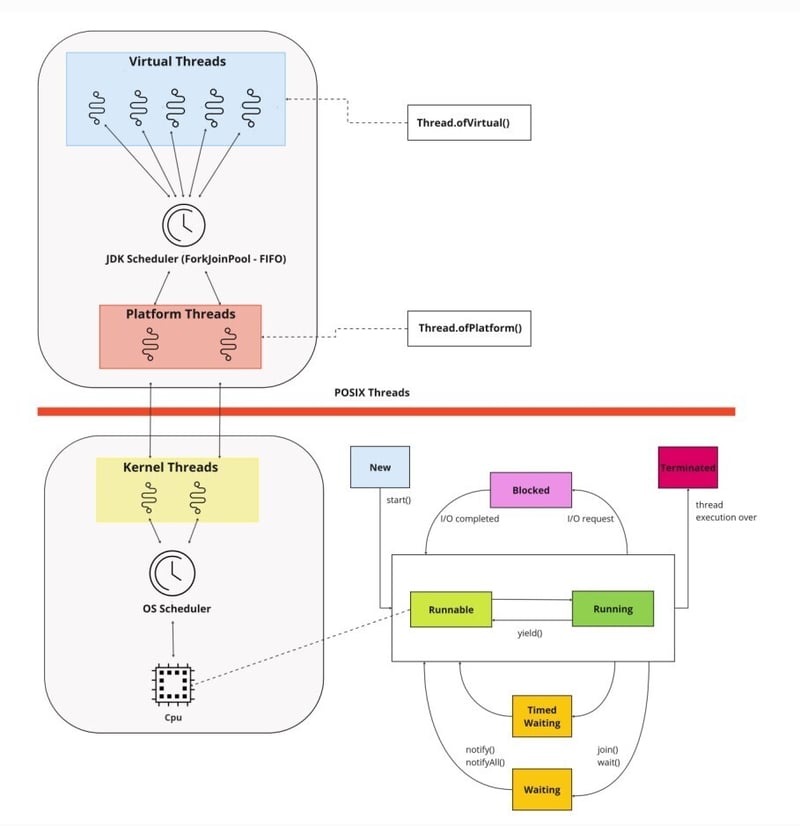探索 JVM 虛擬執行緒機制中的固定
- PHPz原創
- 2024-08-31 16:37:031150瀏覽
Java's virtual threads offer a lightweight alternative to traditional OS threads, enabling efficient concurrency management. But understanding their behavior is crucial for optimal performance. This blog post dives into pinning, a scenario that can impact virtual thread execution, and explores techniques to monitor and address it.
Virtual Threads: A Lightweight Concurrency Approach
Java's virtual threads are managed entities that run on top of the underlying operating system threads (carrier threads). They provide a more efficient way to handle concurrency compared to creating numerous OS threads, as they incur lower overhead. The JVM maps virtual threads to carrier threads dynamically, allowing for better resource utilization.
Managed by the JVM: Unlike OS threads that are directly managed by the operating system, virtual threads are created and scheduled by the Java Virtual Machine (JVM). This allows for finer-grained control and optimization within the JVM environment.
Reduced Overhead: Creating and managing virtual threads incurs significantly lower overhead compared to OS threads. This is because the JVM can manage a larger pool of virtual threads efficiently, utilizing a smaller number of underlying OS threads.
Compatibility with Existing Code: Virtual threads are designed to be seamlessly integrated with existing Java code. They can be used alongside traditional OS threads and work within the familiar constructs like Executor and ExecutorService for managing concurrent.
The figure below shows the relationship between virtual threads and platform threads:

Pinning: When a Virtual Thread Gets Stuck
Pinning occurs when a virtual thread becomes tied to its carrier thread. This essentially means the virtual thread cannot be preempted (switched to another carrier thread) while it's in a pinned state. Here are common scenarios that trigger pinning:
- Synchronized Blocks and Methods: Executing code within a synchronized block or method leads to pinning. This ensures exclusive access to shared resources, preventing data corruption issues.
Code Example:
import java.util.concurrent.ExecutorService;
import java.util.concurrent.Executors;
public class Main {
public static void main(String[] args) throws InterruptedException {
final Counter counter = new Counter();
Runnable task = () -> {
for (int i = 0; i be3c6ba0a699aca98d67df8bee3b84fd {
for (int i = 0; i 4596771306681ecdae85c561b8883cd6 {
for (int i = 0; i < 100; i++) {
counter.increment();
}
};
Thread thread1 = Thread.ofVirtual().start(task);
Thread thread2 = Thread.ofVirtual().start(task);
try {
thread1.join();
thread2.join();
} catch (InterruptedException e) {
throw new RuntimeException(e);
}
System.out.println("Final counter value: " + counter.getCount());
}
}
class Counter {
private int count = 0;
private final ReentrantLock lock = new ReentrantLock();
public void increment() {
lock.lock();
try {
Thread.sleep(100); // This simulates a blocking call
count++;
} catch (InterruptedException e) {
e.printStackTrace();
} finally {
lock.unlock();
}
}
public int getCount() {
return count;
}
}
In the updated example, we use a ReentrantLock instead of a synchronized block. The thread can acquire the lock and release it immediately after it completes its operation, potentially reducing the duration of pinning compared to a synchronized block which might hold the lock for a longer period.
Abschließend
Die virtuellen Threads von Java sind ein Zeugnis für die Entwicklung und die Fähigkeiten der Sprache. Sie bieten eine frische, leichte Alternative zu herkömmlichen Betriebssystem-Threads und schlagen eine Brücke zu einem effizienten Parallelitätsmanagement. Wenn Sie sich die Zeit nehmen, tiefer zu graben und Schlüsselkonzepte wie Thread-Pinning zu verstehen, können Entwickler das Know-how erwerben, um das volle Potenzial dieser leichtgewichtigen Threads auszuschöpfen. Dieses Wissen bereitet Entwickler nicht nur auf die Nutzung kommender Funktionen vor, sondern versetzt sie auch in die Lage, komplexe Probleme der Parallelitätskontrolle in ihren aktuellen Projekten effektiver zu lösen.
以上是探索 JVM 虛擬執行緒機制中的固定的詳細內容。更多資訊請關注PHP中文網其他相關文章!

